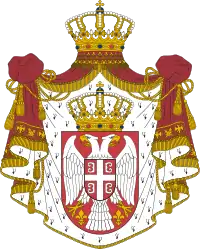Đorđe Vajfert
Đorđe Vajfert (Serbian Cyrillic: Ђорђе Вајферт, German: Georg Weifert; 15 June 1850 – 12 January 1937) was a Serbian industrialist, Governor of the National Bank of Serbia and later Yugoslavia.[1] In addition, he is considered the founder of the modern mining sector in Serbia and a great benefactor.
Đorđe Vajfert Ђорђе Вајферт | |
|---|---|
 | |
| 3rd Governor of the National Bank of Serbia | |
| In office 1890–1902 | |
| Preceded by | Filip Hristić |
| Succeeded by | Tihomilj J. Marković |
| 5th Governor of the National Bank of Serbia (Yugoslavia) | |
| In office 1912–1926 | |
| Preceded by | Tihomilj J. Marković |
| Succeeded by | Ljubomir Srećković |
| Personal details | |
| Born | 15 June 1850 Pančevo, Austrian Empire |
| Died | 12 January 1937 (aged 87) Belgrade, Kingdom of Yugoslavia |
| Nationality | Serbian |
| Signature | |
Biography
Georg Weifert was born in Pančevo, German Banat to a Danube Swabian family.[2][3] From an early age Đorđe Vajfert worked with his father, Ignatz Weifert in Belgrade, in brewing. Theirs was the first brewery in the Kingdom of Serbia. He graduated from the Braumeisterschule in Weihenstephan, near Munich. Then he returned to Serbia and took over the brewery of his father, which he expanded. With the profits he bought a coal mine in Kostolac, then a copper mine in Bor, a Steinberg works at Zaječar and finally a gold mine. With the proceeds from the mines, he was the richest man in Serbia and was considered the greatest industrialist of the future Yugoslavia.
In 1890 Vajfert was appointed Governor of the National Bank of Serbia. He served in this capacity from 1890 to 1902, and again from 1912 to 1914/1918.[1] During this period he acquired a good reputation maintaining the value of the Serbian dinar and in credit. After 1918, because of his good offices, Vajfert was appointed Governor of the National Bank of Yugoslavia.[1] His best-known arrangement as Governor was the conversion of the Austro-Hungarian krone into the new Yugoslav dinar. This also led to great criticism, as the former Serbian dinar was exchanged 1:1 in the new dinar, the Austrian money into a 4:1 ratio – this led to substantial losses of property of those Yugoslavs who formerly lived in Austria-Hungary.

Đorđe Vajfert was an important patron and supporter of humanitarian and cultural institutions. He donated his prized collection of ancient coins and his private library to the University of Belgrade. In Pančevo, from where his parents Ignatz and Anna originated, he left the Roman Catholic Church a small chapel known as Anina crkva (the Church of Anna), in memory of his mother.
Vajfert was a major benefactor in the opening of a large Catholic cemetery in Pancevo where the remains of many family members of Vajfert remain. They also built up a fund for Pancevo St. Anne Catholic Church and many other public and charitable institutions.
Vajfert died on 12 January 1937, at 17:20 pm at his villa in Belgrade. The funeral service was held in the Catholic Church of St. Anne Pancevo 14 January, and the 15th he was buried in the Catholic cemetery Pančevo. The heir to his business empire was his nephew Ferdinand Gramberg.
Since 2001, his portrait is depicted on the 1000 Serbian dinar note.[4] He was awarded the Order of Saint Sava, Order of Karađorđe's Star and Order of the White Eagle.[5]
References
- Governors of the National Bank
- Janković, Milorad (1988). Rat špijuna u Kraljevini Jugoslaviji. Zadružna štampa. p. 15.
- Wouters, Nico; van Ypersele, Laurence (2018). Nations, Identities and the First World War: Shifting Loyalties to the Fatherland. Bloomsbury Publishing. p. 282. ISBN 978-1-35003-644-4.
- Banknotes Withdrown [sic] from circulation
- Acović, Dragomir (2012). Slava i čast: Odlikovanja među Srbima, Srbi među odlikovanjima. Belgrade: Službeni Glasnik. p. 129.CS1 maint: ref=harv (link)
Sources
- Management Giants - Georg Weifert, Profit Magazin, Retrieved on 2017-04-01. (in English)
- The Knight of Serbia, Georg I. Weifert (1850-1937), Association of Serbian Banks, Retrieved on 2017-04-01. (in English)
- Archives of the city of Belgrade, TD, Building dept. F-H-9-1930, file I -165-1942.
- The early years . Led-vajfert.org. Accessed on 2011-12-29
- Politics, no. 10,287 from Wednesday 13 January 1937th, str. 5
- Politics, no. 10,289 from Friday 15 January 1937th, str. 6
- Politics, no. 10,290 from Saturday 16 January 1937th, str. 6
| Government offices | ||
|---|---|---|
| Preceded by Filip Hristić |
Governor of the National Bank of Serbia 1890–1902 |
Succeeded by Tihomilj J. Marković |
| Preceded by Tihomilj J. Marković |
Governor of the National Bank of Serbia 1912–1918 |
Succeeded by Himself, Yugoslavia created |
| Preceded by Himself |
Governor of the National Bank of Yugoslavia 1918–1926 |
Succeeded by Ljubomir Srećković |
